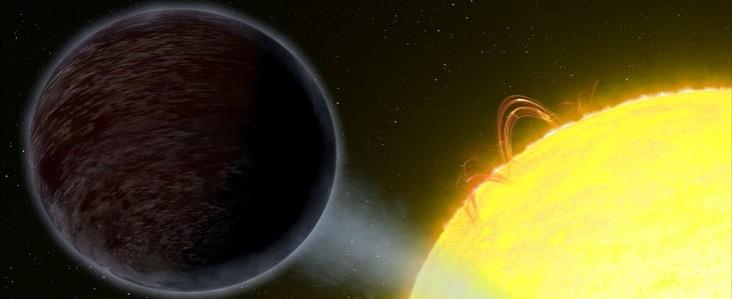
A team of international researchers measured how much light is emitted by a pitch-black planet with the help of NASA's Hubble Space Telescope.
ALSO READ: Bacteria spotted 'shape-shifting' on NASA's ISS; could pose danger to astronauts
Here are the top things to know:
1. The finding has been made by an international group of researchers at McGill University in Montreal, Quebec, Canada and the University of Exeter, UK. They scaled the albedo, which refers to the light being reflected by the exoplanet dubbed WASP-12b in order to unveil more about the composition of the planet's atmosphere.
2. Discovered in 2008, this exoplanet orbits a Sun-like star called WASP-12A which is located at around 1400 light years from it. WASP-12b has a year of just over one Earth day due to the close proximity with its parent star.
3. As exoplanet WASP-12b is situated close to its parent star WASP-12A, closer than the distance at which Mercury orbits the Sun, it is categorised as a hot Jupiter.
"There are other hot Jupiters that have been found to be remarkably black, but they are much cooler than WASP-12b. For those planets, it is suggested that things like clouds and alkali metals are the reason for the absorption of light, but those don't work for WASP-12b because it is so incredibly hot," explains Taylor Bell, the lead author of this research. He is a masters student affiliated with the Institute for Research on Exoplanets.
![An artist's conception shows Kepler-421b, a Uranus-sized transiting exoplanet with the longest known year, circling its star once every 704 days. [Representational image] exoplanet,](https://data1.ibtimes.co.in/en/full/662558/exoplanet.jpg?h=450&l=50&t=40)
4. This exoplanet turned egg-shaped due to the gravitational pull of its parent star. And due to its closeness to the star, its surface temperature of its daylight side would go as high as 2600 degree Celsius.
5. The extreme heat on the day side of the planet doesn't allow cloud formation. It also results in ionisation of alkali metals. Though the heat is not intense enough to break the hydrogen molecules into atomic hydrogen, which makes the atmosphere act like it is that of a low-mass star instead of a planetary atmosphere. The same reason is responsible for the exoplanet's low albedo.
6. Astronomers had scaled the albedo of the exoplanet in 2016 at the time of an eclipse. WASP-12b had passed behind its parent star WASP-12A while the exoplanet was in its full phase. This is considered to be the best method to find an exoplanet's albedo, which the researchers measured the albedo at different wavelengths using Hubble's Space Telescope Imaging Spectrograph. The precision required in this transit observation is ten times more than it's needed in traditional technique.
7. This research led to the finding that WASP-12b's atmosphere comprises atomic hydrogen and helium. The first planet whose albedo measurements were spectrally resolved was HD 189733b, which is also a hot Jupiter, WASP-12b being the second one.
"After we measured the albedo we compared it to spectral models of previously suggested atmospheric models of WASP-12b", elucidated Nikolay Nikolov (University of Exeter, UK), co-author of the study.
"We found that the data match neither of the two currently proposed models," Nikolov added.
8. The astronomers were able to find out whether the exoplanet emitted more light towards the red or blue end of the spectrum. They found that the exoplanet HD 189733b possessed a deep blue colour, whereas WASP-12b didn't emit light at any wavelength, which made it pitch black. The light it gave away was because of the high temperature it had which provided the exoplanet with a red hue which was just like that of a hot glowing metal.








